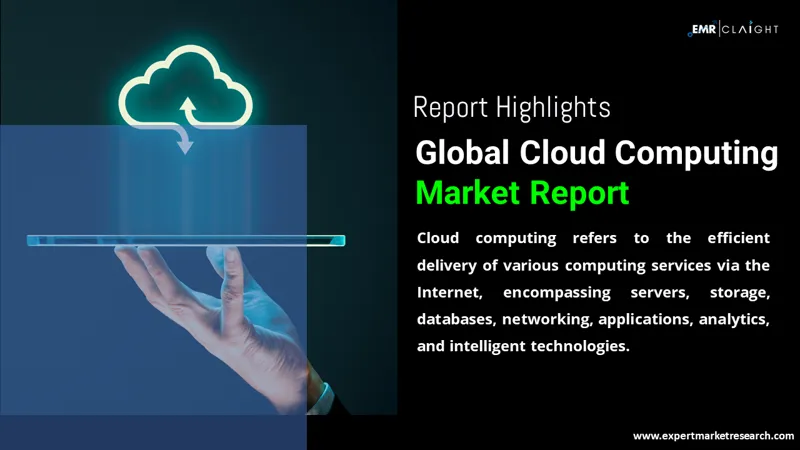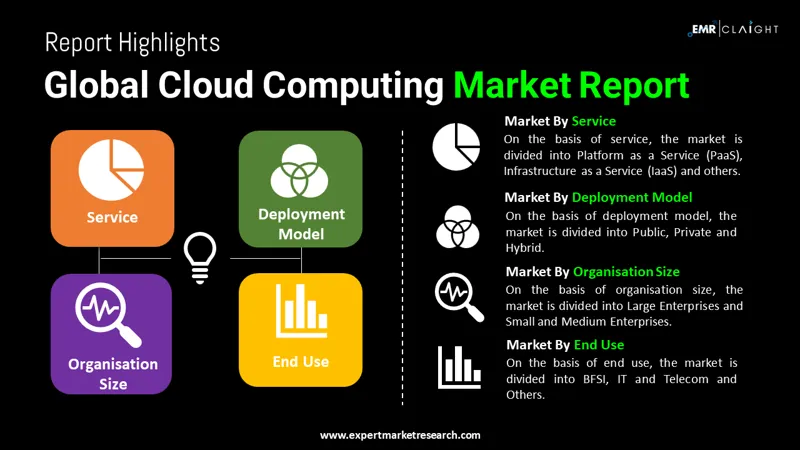
Consumer Insights
Uncover trends and behaviors shaping consumer choices today
Procurement Insights
Optimize your sourcing strategy with key market data
Industry Stats
Stay ahead with the latest trends and market analysis.
The global cloud computing market size USD 612.49 Billion in 2025. The market is further expected to grow at a CAGR of 15.00% during the forecast period of 2026-2035 to reach a value of USD 2477.86 Billion by 2035.
Base Year
Historical Period
Forecast Period
Compound Annual Growth Rate
15%
Value in USD Billion
2026-2035
*this image is indicative*
| Global Cloud Computing Market Report Summary | Description | Value |
| Base Year | USD Billion | 2025 |
| Historical Period | USD Billion | 2019-2025 |
| Forecast Period | USD Billion | 2026-2035 |
| Market Size 2025 | USD Billion | 612.49 |
| Market Size 2035 | USD Billion | 2477.86 |
| CAGR 2019-2025 | Percentage | XX% |
| CAGR 2026-2035 | Percentage | 15.00% |
| CAGR 2026-2035 - Market by Region | Latin America | 16.8% |
| CAGR 2026-2035 - Market by Country | India | 17.4% |
| CAGR 2026-2035 - Market by Country | Brazil | 17.1% |
| CAGR 2026-2035 - Market by Organization Size | Small and Medium Enterprises | 15.7% |
| CAGR 2026-2035 - Market by Deployment Model | Hybrid | 16.1% |
| Market Share by Country 2025 | Canada | 3.4% |
Cloud computing is the delivery of computing services via the Internet (the cloud), including as servers, storage, databases, networking, apps, analytics, and intelligence, to enable faster innovation, more adaptable resources, and economies of scale, which drives the demand for the cloud computing market.

Read more about this report - REQUEST FREE SAMPLE COPY IN PDF
The global market for cloud computing is a rapidly emerging industry that is adopting various technological reforms to boost and sustain the system, thus, ensuring the continued cloud computing industry growth.
Enterprises are concerned about the expenses of on-premises data hosting, including implementation and maintenance. Furthermore, organisations face two additional challenges, personnel expenditures and downtime issues. The current competitive environment and global economic conditions have accelerated the use of cost-effective business model restructuring measures. Another reason driving cloud computing service acceptance is organisations' rising push toward digital transformation and increased customer interaction, both of which are cutting enterprise expenses. Furthermore, the cloud provides a pay-as-you-go paradigm, allowing businesses to pay for cloud services depending on their usage, resulting in lower prices which further enables the growth of the cloud computing market.
As per industry reports, spending on compute and storage infrastructure products for cloud deployments, including dedicated and shared IT environments, rose 18.5% year on year to USD 31.8 billion in the fourth quarter of 2023. Cloud infrastructure spending continues to outpace non-cloud spending, which increased by 16.4% year on year to USD 18.9 billion in Q4’23. Unit shipments in the cloud infrastructure market fell 22.8% in the quarter, while average selling prices (ASPs) increased due to higher-than-usual GPU server shipments to hyper scalers.
Further, there has been a notable increase in worldwide IT spending from 2022 to 2023, growing from USD 4,401.809 billion to USD 5,643.628 billion. Data centre systems spending rose from USD 216.095 billion to USD 224.123 billion, marking a 3.7% growth. Devices spending decreased by 4.6%, from USD 717.048 billion to USD 684.342 billion. Software experienced substantial growth of 12.3%, rising from USD 793.839 billion to USD 891.386 billion.

Read more about this report - REQUEST FREE SAMPLE COPY IN PDF
“Global Cloud Computing Market Report and Forecast 2026-2035” offers a detailed analysis of the market based on the following segments:
Market Breakup by Service
Market Breakup by Deployment Model
Market Breakup by Organisation Size
Market Breakup by End Use
Market Breakup by Region
The growth of the cloud computing industry can also be attributed to the cost efficiency, which lowers the need for huge capital expenditures on hardware and infrastructure, and the pay-as-you-go model, which allows organisations to pay only for the services they use. Furthermore, the scalability and flexibility of cloud services enable organizations to readily alter resources based on demand, allowing them to respond to changing workloads and market conditions.
The cloud computing market dynamics and trends are being driven by expanding digital transformation initiatives across sectors, as well as the rising usage of advanced technologies, both of which are significant drivers of market growth.
Favourable government efforts, such as the Digital India program and the implementation of data protection legislation, are also expected to propel the cloud computing demand growth.
| CAGR 2026-2035 - Market by | Country |
| India | 17.4% |
| Brazil | 17.1% |
| USA | 14.2% |
| UK | 14.1% |
| China | 13.4% |
| Canada | XX% |
| Germany | XX% |
| France | XX% |
| Italy | 12.3% |
| Japan | XX% |
| Australia | XX% |
| Saudi Arabia | XX% |
| Mexico | XX% |
These companies are market leaders in cloud computing services, providing a diverse variety of solutions such as infrastructure as a service (IaaS), platform as a service (PaaS), and software as a service (SaaS). They are well-known for their innovative technologies, massive global data centre networks, and complete cloud platforms, which cater to enterprises of all sizes and enable digital transformation, scalability, and innovation across a wide range of industries.




*While we strive to always give you current and accurate information, the numbers depicted on the website are indicative and may differ from the actual numbers in the main report. At Expert Market Research, we aim to bring you the latest insights and trends in the market. Using our analyses and forecasts, stakeholders can understand the market dynamics, navigate challenges, and capitalize on opportunities to make data-driven strategic decisions.*
Get in touch with us for a customized solution tailored to your unique requirements and save upto 35%!
The global cloud computing market value is projected to grow at a CAGR of 15.00% between 2026 and 2035.
The market is estimated to witness healthy growth in the forecast period of 2026-2035 to reach USD 2477.86 Billion by 2035.
The market is being driven by the rising popularity of public cloud services and the increasing focus of organisations to enhance their operational efficiency.
The increasing implementation of cost-effective business model restructuring steps, digital transformation of organisations, and the growing concerns regarding high costs associated with hosting data on-premises are the key trends guiding the market growth.
The market is broken down into North America, Europe, Asia Pacific, Latin America, the Middle East, and Africa.
The leading service segments in the market are Software as a Service (SaaS), Platform as a Service (PaaS), and Infrastructure as a Service (IaaS).
The significant modes of application of Cloud Computing in the market are Public, Private, and Hybrid.
The various organisation sizes considered in the market report are large enterprises and small and medium enterprises.
The several end uses of cloud computing are BFSI, IT and telecom, retail and consumer goods, manufacturing, energy and utilities, healthcare, media and entertainment, and government and public sector, among others.
The competitive landscape consists of Microsoft Corporation, Amazon Web Services, Oracle Corporation, Google LLC, SAP SE, among others.
In 2025, the market reached a value of approximately USD 612.49 Billion.
Explore our key highlights of the report and gain a concise overview of key findings, trends, and actionable insights that will empower your strategic decisions.
| REPORT FEATURES | DETAILS |
| Base Year | 2025 |
| Historical Period | 2019-2025 |
| Forecast Period | 2026-2035 |
| Scope of the Report |
Historical and Forecast Trends, Industry Drivers and Constraints, Historical and Forecast Market Analysis by Segment:
|
| Breakup by Service |
|
| Breakup by Deployment Model |
|
| Breakup by Organisation Size |
|
| Breakup by End Use |
|
| Breakup by Region |
|
| Market Dynamics |
|
| Competitive Landscape |
|
| Companies Covered |
|
| Report Price and Purchase Option | Explore our purchase options that are best suited to your resources and industry needs. |
| Delivery Format | Delivered as an attached PDF and Excel through email, with an option of receiving an editable PPT, according to the purchase option. |
Datasheet
One User
USD 2,499
USD 2,249
tax inclusive*
Single User License
One User
USD 3,999
USD 3,599
tax inclusive*
Five User License
Five User
USD 4,999
USD 4,249
tax inclusive*
Corporate License
Unlimited Users
USD 5,999
USD 5,099
tax inclusive*
*Please note that the prices mentioned below are starting prices for each bundle type. Kindly contact our team for further details.*
Flash Bundle
Small Business Bundle
Growth Bundle
Enterprise Bundle
*Please note that the prices mentioned below are starting prices for each bundle type. Kindly contact our team for further details.*
Flash Bundle
Number of Reports: 3
20%
tax inclusive*
Small Business Bundle
Number of Reports: 5
25%
tax inclusive*
Growth Bundle
Number of Reports: 8
30%
tax inclusive*
Enterprise Bundle
Number of Reports: 10
35%
tax inclusive*
How To Order

Select License Type
Choose the right license for your needs and access rights.

Click on ‘Buy Now’
Add the report to your cart with one click and proceed to register.

Select Mode of Payment
Choose a payment option for a secure checkout. You will be redirected accordingly.
Gain insights to stay ahead and seize opportunities.

Get insights & trends for a competitive edge.

Track prices with detailed trend reports.

Analyse trade data for supply chain insights.

Leverage cost reports for smart savings

Enhance supply chain with partnerships.

Connect For More Information
Our expert team of analysts will offer full support and resolve any queries regarding the report, before and after the purchase.
Our expert team of analysts will offer full support and resolve any queries regarding the report, before and after the purchase.
We employ meticulous research methods, blending advanced analytics and expert insights to deliver accurate, actionable industry intelligence, staying ahead of competitors.
Our skilled analysts offer unparalleled competitive advantage with detailed insights on current and emerging markets, ensuring your strategic edge.
We offer an in-depth yet simplified presentation of industry insights and analysis to meet your specific requirements effectively.
Share